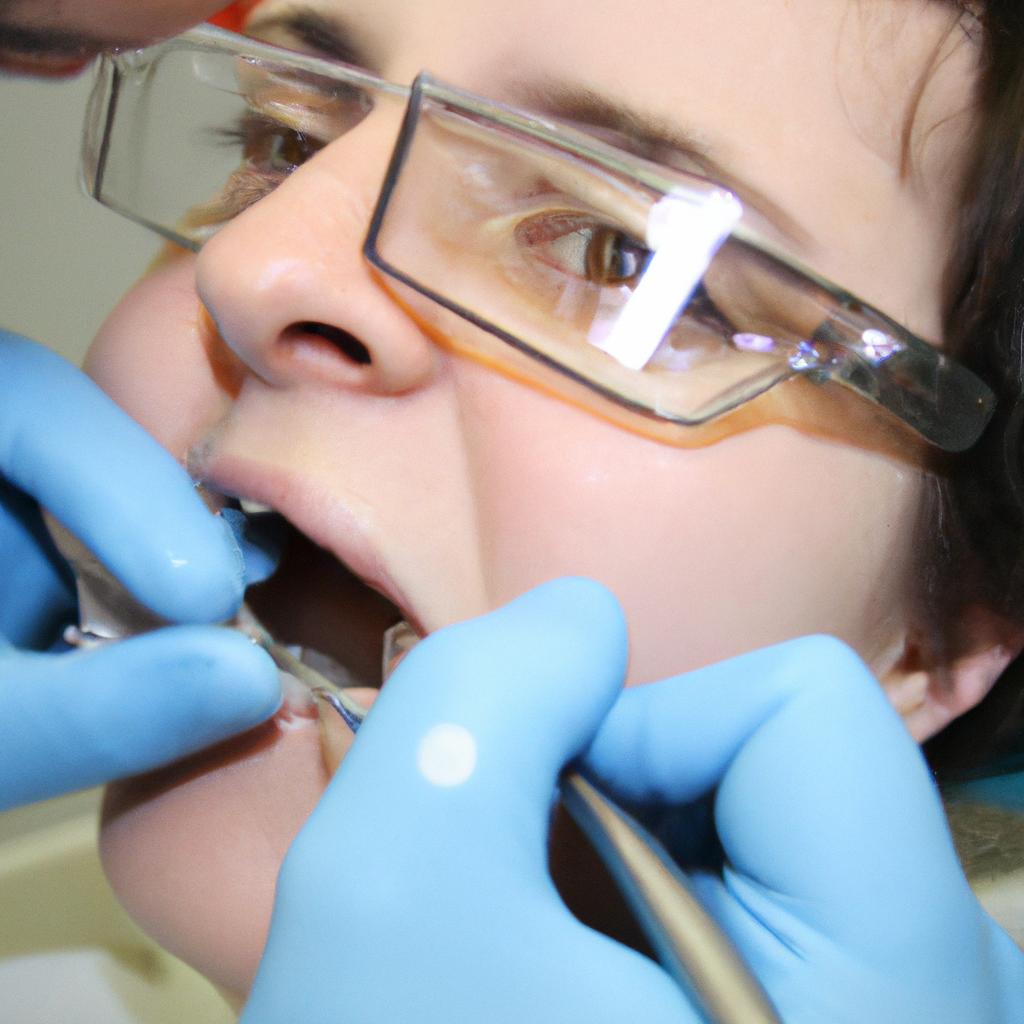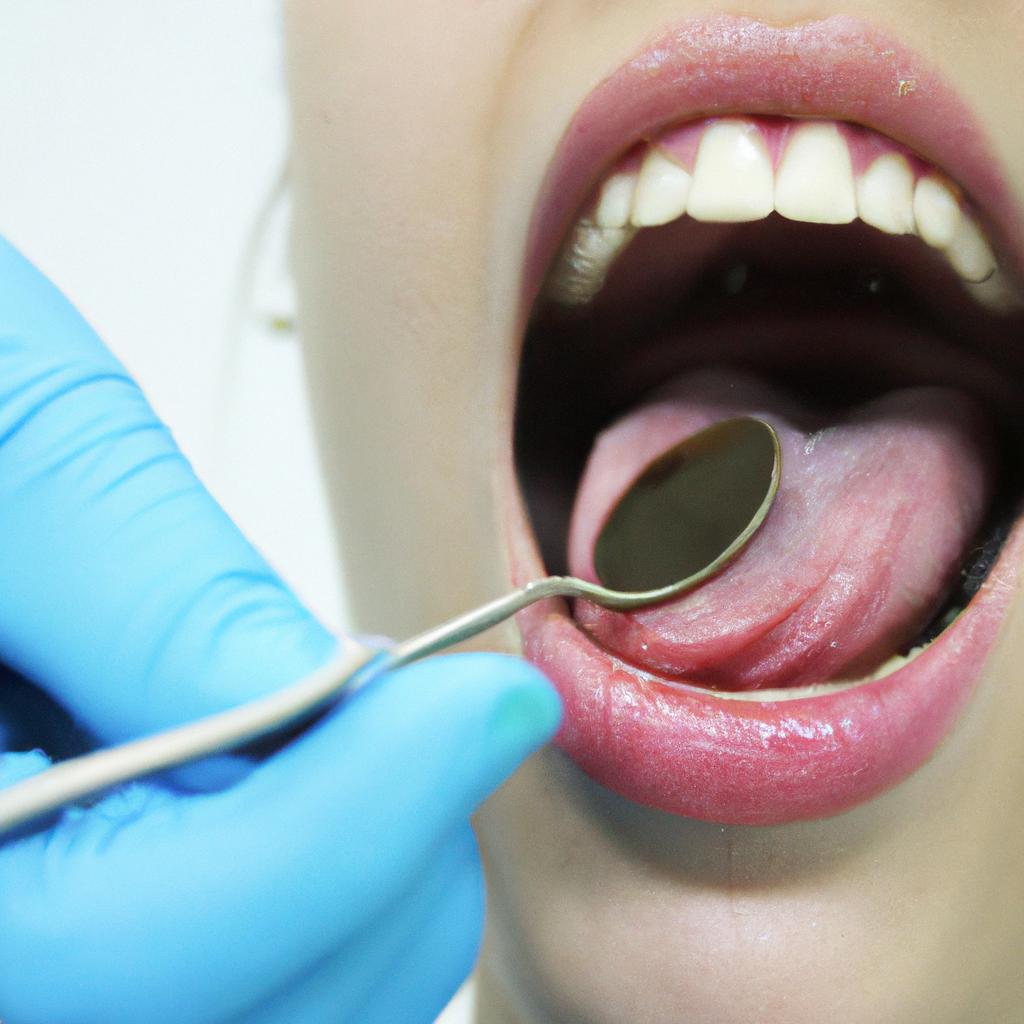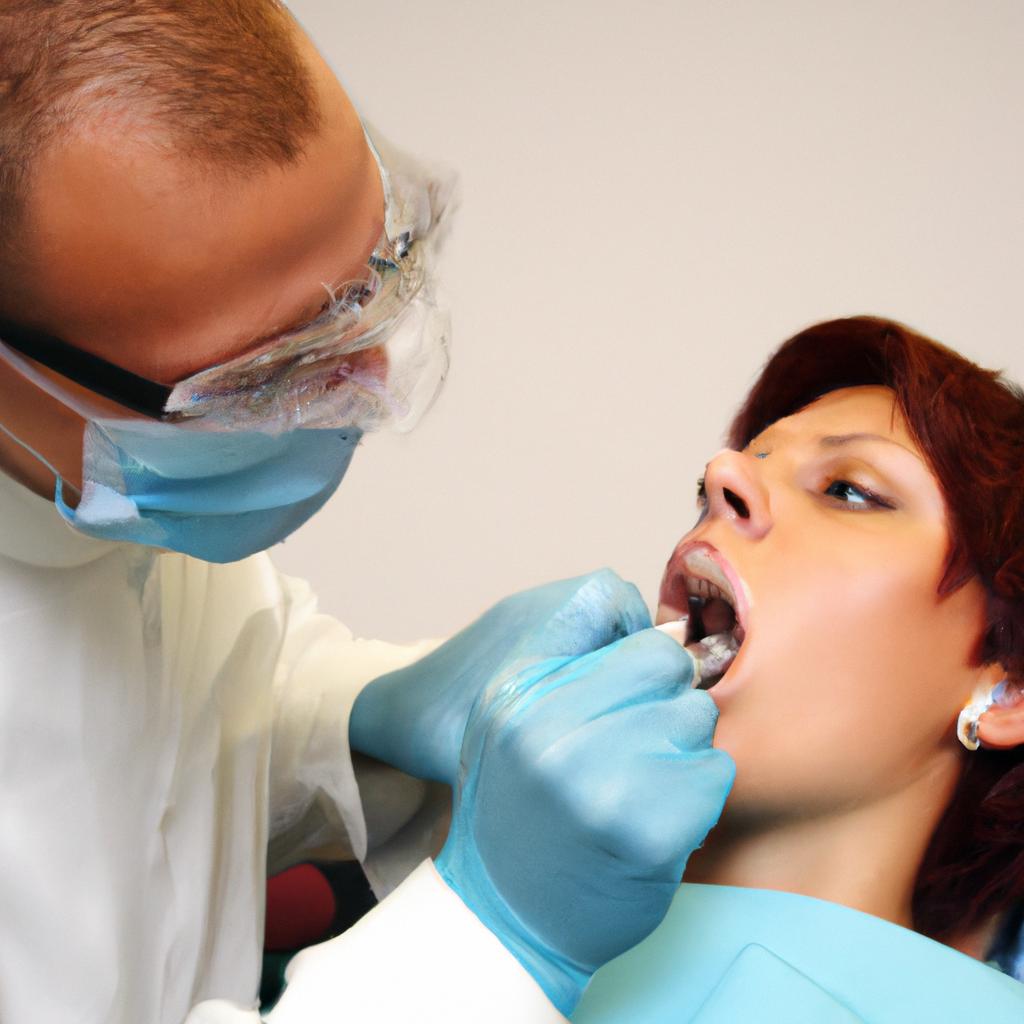Diagnosis in Periodontics: An Informational Guide

Periodontics, the branch of dentistry that focuses on the diagnosis and treatment of diseases affecting the supporting structures of teeth, plays a crucial role in maintaining oral health. Accurate diagnosis is essential for effective management of periodontal conditions, as it enables targeted interventions tailored to each patient’s specific needs. In this informational guide, we aim to provide a comprehensive overview of the diagnostic process in periodontics, exploring its significance and various techniques employed.
Consider a hypothetical case study where a middle-aged patient presents with symptoms such as bleeding gums, bad breath, and loose teeth. These distressing signs may indicate underlying periodontal disease. Without prompt and accurate diagnosis, these initial symptoms could progress into more severe manifestations like gum recession or tooth loss. The importance of early detection cannot be overstated; timely intervention can prevent further damage and improve long-term prognosis. Through this article, readers will gain an understanding of how clinicians approach diagnosing periodontal disease and learn about different tools utilized in this process.
In the subsequent sections, we will delve into key aspects related to the diagnostic phase in periodontics. This includes examination methods used by dental professionals to assess patients’ oral health status, such as clinical evaluation and radiographic imaging. Furthermore, we will explore the role of periodontal charting, which involves measuring and recording various parameters to assess the severity of periodontal disease. Additionally, we will discuss the importance of patient history and risk assessment in aiding diagnosis, as well as the potential use of advanced diagnostic techniques like genetic testing or microbial analysis.
By familiarizing ourselves with these diagnostic tools and techniques, we can better understand how clinicians arrive at an accurate diagnosis in periodontics. This knowledge empowers patients to actively participate in their own oral health care by recognizing symptoms early on and seeking appropriate professional help. Furthermore, it enables dental professionals to provide targeted treatment plans that address individual patient needs effectively.
Overall, this guide aims to shed light on the diagnostic process in periodontics and highlight its significance in maintaining oral health. Whether you are a patient experiencing concerning symptoms or a healthcare professional looking to expand your knowledge, this article equips you with valuable insights into diagnosing and managing periodontal diseases.
Understanding Periodontal Diseases
Periodontal diseases, commonly referred to as gum diseases, are a group of inflammatory conditions that affect the tissues surrounding and supporting the teeth. These diseases range from mild gingivitis to severe periodontitis, which can lead to tooth loss if left untreated. To illustrate the significance of these diseases, let us consider a hypothetical case study of a middle-aged individual who presented with bleeding gums and bad breath. Upon examination, it was revealed that this person had advanced periodontitis, characterized by deep pockets between their teeth and gums.
To fully comprehend the complexities associated with periodontal diseases, it is crucial to understand their underlying causes. The primary cause of these diseases is poor oral hygiene practices leading to plaque accumulation on the teeth and along the gumline. Plaque harbors bacteria that release toxins, triggering an immune response in the body. This response results in inflammation of the gums (gingivitis), which, if not addressed promptly, can progress into more severe forms of periodontal disease.
It is important for individuals to be aware of certain key factors that contribute to the development and progression of periodontal diseases:
- Tobacco use: Smoking or chewing tobacco significantly increases the risk of developing gum disease.
- Diabetes: Poorly controlled diabetes compromises the body’s ability to fight infections, including those affecting the gums.
- Hormonal changes: Fluctuations in hormone levels during pregnancy or menopause may make women more susceptible to gum problems.
- Certain medications: Some medications have side effects that can negatively impact gum health.
| Risk Factors | Description | Impact |
|---|---|---|
| Poor oral hygiene | Inadequate brushing and flossing habits allow plaque buildup on teeth and gums | Increases bacterial growth and exacerbates inflammation |
| Genetics | Genetic predisposition influences susceptibility to gum disease | Individuals with a family history of periodontal disease may be at higher risk |
| Stress | Chronic stress weakens the immune system, making it harder for the body to resist infections | Increases vulnerability to gum diseases and impairs healing |
| Nutrition | Poor diet lacking in essential nutrients can compromise oral health | Weakens gums’ ability to fight infection and repair damaged tissues |
Understanding the causes and risk factors associated with periodontal diseases is crucial in promoting prevention and early intervention. In the subsequent section, we will explore common symptoms that individuals should be vigilant about, as they serve as indicators of potential gum disease progression. By recognizing these symptoms promptly, one can seek appropriate dental care and minimize the adverse effects on their oral health.
[Transition sentence into “Common Symptoms of Periodontal Diseases” section] As our understanding of periodontal diseases deepens, it becomes imperative to identify red flags indicative of possible gum disease progression.
Common Symptoms of Periodontal Diseases
Understanding Periodontal Diseases and their Common Symptoms
Periodontal diseases are a group of inflammatory conditions that affect the gums and tissues surrounding the teeth. These diseases can range in severity from mild gingivitis to more advanced periodontitis, which can lead to tooth loss if left untreated. To further comprehend the impact of these diseases, let us consider an example: Mr. Smith, a 45-year-old individual with a history of poor oral hygiene practices, presented with red, swollen gums that bled easily during brushing and flossing. Upon examination, his dentist diagnosed him with chronic periodontitis.
To better recognize and diagnose periodontal diseases like chronic periodontitis, it is essential to be aware of their common symptoms. Here are some indicative signs that may suggest the presence of such diseases:
- Persistent bad breath (halitosis)
- Gum recession or visible tooth roots
- Loose or shifting teeth
- Formation of deep pockets between gums and teeth
These symptoms not only indicate potential gum problems but also evoke concerns about overall oral health. It is crucial for individuals experiencing any of these signs to seek professional dental care promptly.
In order to facilitate a comprehensive understanding of periodontal diseases and their manifestations, we present a table summarizing various symptoms associated with different stages of these conditions:
| Stage | Symptoms |
|---|---|
| Gingivitis | Redness, swelling, bleeding gums |
| Early Periodontitis | Bad breath, receding gums |
| Moderate Periodontitis | Tooth sensitivity, loose teeth |
| Advanced Periodontitis | Severe bone loss, abscess formation |
By listing out the symptoms according to disease progression stages in this table format, readers gain a clear visual representation while simultaneously being informed about possible consequences if treatment is delayed.
As awareness about periodontal diseases grows through understanding their symptoms and impacts on oral health, it becomes imperative to explore diagnostic tools in periodontics. By utilizing these tools, dental professionals can accurately assess the extent of disease progression and develop appropriate treatment plans tailored to each patient’s unique needs.
Moving forward, let us delve into the various diagnostic tools employed in the field of periodontics to aid in precise diagnosis and subsequent management of periodontal diseases.
Diagnostic Tools in Periodontics
To accurately diagnose periodontal diseases, various diagnostic tools are employed by dental professionals. These tools enable the identification and evaluation of the extent and severity of periodontal conditions. By utilizing these methods, dentists can provide appropriate treatment plans tailored to each patient’s needs.
Example Case Study:
Consider a hypothetical case study involving a 45-year-old patient who presents with symptoms such as bleeding gums, persistent bad breath, and loose teeth. The dentist conducts a thorough examination using different diagnostic tools to determine the underlying cause of these symptoms.
Diagnostic Tools:
- Clinical Examination: This initial step involves assessing the patient’s oral health visually and manually. Dentists examine the gum tissues for signs of inflammation, recession, or swelling. They also use probes to measure pocket depths around teeth, looking for indications of attachment loss.
- Radiographic Imaging: X-rays play an essential role in diagnosing periodontal diseases. They provide valuable information about bone levels, calculus deposits, root fractures, and other abnormalities that may not be visible during clinical examinations.
- Microbiological Analysis: To identify specific bacteria present in periodontal pockets, samples from diseased sites are collected and analyzed in laboratories. This enables dentists to understand the microbial composition contributing to disease progression.
- Genetic Testing: Advances in genetic research have allowed dental professionals to explore genetic factors associated with increased susceptibility to periodontal diseases. Certain gene variations may influence an individual’s response to infection or inflammatory processes.
- Early detection through proper diagnosis helps prevent further damage
- Accurate diagnosis leads to targeted treatment approaches
- Timely intervention improves overall oral health outcomes
- Proper management reduces the risk of tooth loss
Emotional Table:
| Diagnostic Tool | Purpose | Benefits |
|---|---|---|
| Clinical Examination | Visual assessment of oral health | Early detection |
| Radiographic Imaging | Identification of bone and root issues | Accurate treatment planning |
| Microbiological Analysis | Determination of bacterial presence | Tailored antimicrobial therapy |
| Genetic Testing | Assessment of genetic predisposition | Personalized preventive measures |
In light of these diagnostic tools, it becomes evident that early diagnosis is crucial in managing periodontal diseases effectively. Understanding the importance of timely identification and intervention can significantly impact patient outcomes and long-term oral health.
The Importance of Early Diagnosis
Imagine a patient, Sarah, who visits her dentist complaining of persistent gum bleeding and bad breath. To determine the underlying cause of these symptoms, the dentist employs various diagnostic tools commonly used in periodontics. These tools play a crucial role in accurately assessing the state of oral health and identifying potential periodontal diseases.
Diagnostic Tools:
-
Clinical Examination: The initial step involves a comprehensive assessment by visually examining the gums, teeth, tongue, and other intraoral structures for any abnormalities or signs of inflammation. In Sarah’s case, her dentist might observe redness and swelling along with pockets between the gums and teeth, indicating possible gingivitis or even early-stage periodontitis.
-
Radiographic Imaging: X-rays are valuable aids in diagnosing periodontal conditions that may not be readily visible during clinical examination alone. By capturing images of bone levels surrounding the teeth, radiographs help identify bone loss caused by advanced periodontitis. For instance, if Sarah’s x-ray reveals significant vertical bone resorption around certain teeth accompanied by deep pocket formation, it could suggest severe periodontal disease requiring immediate intervention.
-
Microbiological Analysis: Unseen to the naked eye, bacteria residing within dental plaque can significantly influence the progression of periodontal diseases. Utilizing microbiological analysis techniques such as DNA testing or culturing samples obtained from periodontal pockets allows dentists to identify specific bacterial strains involved in an infection. This information is vital for tailoring appropriate treatment strategies to target those particular pathogens effectively.
To emphasize the importance of utilizing diagnostic tools in periodontics effectively, consider the following emotional aspects:
- Early detection through thorough examination can prevent irreversible damage to tooth-supporting tissues.
- Accurate diagnosis enables personalized treatment plans tailored to individual patients’ needs.
- Timely identification allows prompt interventions that mitigate the risk of tooth loss.
- Enhanced patient satisfaction arises from improved treatment outcomes and long-term oral health.
Emotional Table:
| Emotional Impact | Diagnostic Tools in Periodontics |
|---|---|
| Relief | Early detection through clinical examination |
| Confidence | Radiographic imaging reveals bone levels |
| Empowerment | Microbiological analysis targets specific pathogens |
| Satisfaction | Tailored treatment plans based on accurate diagnosis |
The Role of Diagnostic Tools:
Adopting a multidimensional approach that combines clinical examination, radiographic imaging, and microbiological analysis empowers dental professionals to make precise diagnoses. By utilizing these diagnostic tools effectively, they can provide patients like Sarah with timely interventions tailored to their unique needs. This proactive approach not only ensures better treatment outcomes but also improves overall patient satisfaction.
Moving forward, it is essential to differentiate periodontal diseases from other oral conditions to develop appropriate management strategies.
Differentiating Periodontal Diseases from Other Oral Conditions
Early and accurate diagnosis of periodontal diseases is crucial to prevent further progression and potential tooth loss. However, it can be challenging for clinicians to differentiate periodontal diseases from other oral conditions due to overlapping clinical features. To illustrate this point, let’s consider a hypothetical case study.
Imagine a patient presenting with redness, inflammation, and bleeding gums. At first glance, these symptoms could indicate gingivitis or even an acute bacterial infection such as necrotizing ulcerative gingivitis (NUG). However, upon closer examination, the clinician may discover additional signs such as deep periodontal pockets and bone loss suggestive of chronic periodontitis.
To help distinguish periodontal diseases from other oral conditions, several key factors should be considered:
-
Clinical Presentation: Periodontal diseases often present with specific clinical features like gum recession, loose teeth, and pus discharge from periodontal pockets. In contrast, other oral conditions such as oral candidiasis or traumatic ulcers may exhibit different patterns and characteristics.
-
Radiographic Findings: Utilizing radiographs can provide valuable insights into the extent of bone loss associated with periodontal diseases. These findings are distinct from those seen in caries or periapical lesions caused by pulpal pathology.
-
Microbiological Analysis: Microorganisms play a significant role in the pathogenesis of periodontal diseases. Analyzing microbial samples through techniques like DNA testing can aid in identifying specific pathogens associated with various forms of periodontitis.
-
Histopathological Examination: When necessary, obtaining tissue samples for histopathological analysis allows for a more definitive diagnosis by evaluating inflammatory infiltrates and cellular changes within the affected tissues.
| Condition | Key Features | Treatment |
|---|---|---|
| Gingivitis | Mild inflammation, reversible | Oral hygiene maintenance |
| Chronic Periodontitis | Progressive bone loss, deep pockets | Scaling and root planing |
| Necrotizing Ulcerative | Painful ulcerations, necrosis of tissues | Antibiotics and debridement |
| Gingivitis (NUG) | ||
| (affecting the gums only) | Acute inflammation, punched-out papillae |
By recognizing these differentiating factors and utilizing the appropriate diagnostic tools, clinicians can make informed decisions regarding treatment options based on an accurate diagnosis. In the subsequent section about “Treatment Options based on Diagnosis,” we will explore various strategies to manage periodontal diseases effectively.
Now let’s transition into the next section by discussing the importance of prompt intervention in preventing disease progression.
Treatment Options based on Diagnosis
In the previous section, we explored the challenges of differentiating periodontal diseases from other oral conditions. Now, let us delve into the various treatment options based on diagnosis. To illustrate this further, let’s consider a hypothetical case study.
Imagine a patient presenting with symptoms such as gum inflammation, bleeding upon brushing and flossing, and persistent bad breath. After a thorough examination and diagnostic tests, it is determined that the patient has chronic periodontitis. This condition requires tailored treatment to address not only the symptoms but also the underlying causes.
When developing a treatment plan for patients diagnosed with periodontal diseases like chronic periodontitis, several factors need to be considered:
-
Disease severity: The extent and severity of periodontal disease can vary among individuals. Treatment options will depend on whether the disease is mild, moderate, or advanced. This information guides clinicians in determining appropriate interventions to manage the condition effectively.
-
Patient compliance: Successful management of periodontal diseases relies heavily on patient adherence to prescribed treatments and recommendations. Educating patients about their condition and actively involving them in decision-making processes enhances their understanding and commitment to treatment plans.
-
Risk assessment: Identifying risk factors associated with periodontal diseases allows clinicians to tailor treatment plans accordingly. Factors such as smoking habits, systemic health conditions (e.g., diabetes), genetic predisposition, and poor oral hygiene practices impact disease progression and response to therapy.
-
Maintenance requirements: After initial treatment for periodontal diseases, regular maintenance visits become crucial in preventing relapse or recurrence of disease activity. Developing an appropriate recall schedule ensures ongoing monitoring, reinforcement of oral hygiene practices, and timely intervention if needed.
To help visualize some key information related to diagnosing and treating periodontal diseases effectively, here is a table summarizing common types of periodontal diseases along with their clinical features:
| Disease Type | Clinical Features |
|---|---|
| Chronic Periodontitis | Gum inflammation, bleeding upon brushing, bad breath |
| Aggressive Periodontitis | Rapid bone loss, familial aggregation of cases |
| Necrotizing Periodontal Diseases | Painful ulcers, necrosis of gum tissue |
| Periodontal Abscess | Localized swelling, pain |
In conclusion, the diagnosis and differentiation of periodontal diseases from other oral conditions are critical in determining appropriate treatment strategies. By considering factors such as disease severity, patient compliance, risk assessment, and maintenance requirements, clinicians can develop customized treatment plans to manage these conditions effectively. The table above provides a snapshot of common types of periodontal diseases along with their clinical features, aiding in understanding the nuances of each condition.





